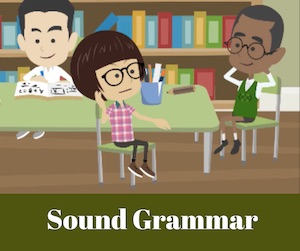Views Listening Lessons

What are the Views Listening Lessons?
These listening lessons are the main activities on elllo. They offer a complete listening lesson for ESL learners and teachers. Each lesson contains natural English, usually in the form of a conversation between two speakers. The lessons come with an audio recording of a conversation, a transcript, a quiz, and vocabulary lesson. Most of the newer lessons also use video to give visual support.
Why are listening lessons, like Views, so beneficial to students and teachers?
The main benefit of these lessons is that the English is natural. Most English listening lessons in commercial textbooks are scripted, thus unnatural. As a result, the language is very different than authentic English.
Say it like it is!
There are many things that are different with English that is spoken naturally, versus scripted English that is read by voice actors.
Grammar
The grammar is usually easier because if people are speaking naturally, they do not have time to make complex sentences, thus the simple grammar. When language is written, it tends to be needlessly complex, even if the writer intends to keep it simple.
Vocabulary
Spoken English usually contains simpler vocabulary than written language. By nature, speakers use the easiest words possible to get their meaning across. As a result, the transcripts of natural speech are often very easy to read, even for beginner students.
Pronunciation
Spoken language has unique pronunciation. In natural speech, speakers are much more likely to use contractions, reductions, and link words together to make blended sounds. Students who learn English primarily through reading will have a much harder time mastering pronunciation than students who listen to a lot of natural speech. They will also have a harder time becoming fluent listeners of English.
World English(es)
English is spoken all over the world. English in one country may differ greatly from English in another. Thus, students need to be familiar with many varieties of English, both native and International. It is important for students to study World English(es) so they can communicate with people with different accents and ways of communicating. elllo provides perhaps the largest collection of listening lessons featuring World English(es).
How can students learn natural English?
The best way to learn natural English is to listen to a lot of it. By listening to a lot of natural English, students can learn how English speakers use grammar and vocabulary naturally, as well as how authentic English sounds.
The Power of Extensive Listening
ELLLO is designed to provide ample practice for extensive listening, which is considered the best way to learn a language by many linguists and language teachers. Nearly everyone in the world learns their first language by listening, and only learn to read after they have become fluent in their first language. elllo provides similar path by providing ample practice to develop listening, as well as reading.
Don't Read Too Much Into This
While reading is a powerful tool to learn English, many students are overreliant on reading as a means of instruction. If students study a lot by mainly reading, they risk developing a false sense of their actual language ability. Because students can control the pace of how fast they read, and pause at any time to look up a word, or go over a text, English is more manageable when they read it.
However, these same students might be frustrated or disheartened when they have to use English as verbal communication in international settings. They may struggle hearing what people say, due to intricacies of natural speech, or uniqueness of accents. They may also struggle to be understood if they have stilted pronunciation, from learning how to speak through reading, and not listening. Stilted speech occurs when students develop pronunciation patterns by saying language how they think it sounds, rather than how it actually sounds. Kind of like this recording. All jokes aside!
Mom Knows Best
When children first learn to read, it is usually from their parents. Studies show that when parents reed to their children, they develop strong language skills in their first language. At this stage, the students hear and read the language at the same time. Unfortunately, most language learners do not have someone to read to them. The transcripts on elllo can work as an alternative to this. Students can listen to the script as they hear the conversations, much like how a parent reads to a child.
Study Plan for Listening Lessons:
1) Listen for Fun
In the first listening, students should listen to the recording for enjoyment and to get the main idea that the speakers are expressing.
2) Take a Quiz
In the second listening, students should listen again and complete the quiz provided with the lesson. This quiz helps students check their listening comprehension. These quizzes are great practice activities that students can do on their smartphone for free!
In order to practice test-taking, students can do this activity first. The students should preview the questions, then play the video and take the quiz. They can check their answers by clicking the buttons below the quiz.
3) Read and Listen
In the third listening, students should listen and read the text simultaneously. Students will be able to notice language they may have missed before. Each lesson comes with words or phrases highlighted in blue that are worthy of instruction.
4) Learn the Vocabulary
Students can now learn the key words in the lesson. These words are often special vocabulary or multi-word expressions or idioms. These vocabulary items are often hard to learn with a dictionary.
The vocabulary lessons provide audio support so students can hear the words multiple times to learn their correct pronunciation. Each word is spoken at least five times. Also, students can check their comprehension by taking the interactive vocabulary quiz.
Students and teachers can do this lesson on any device: such as a computer, tablet or mobile phone!
Take in the View!
Below are some recommended lessons for Views.
There are 1500 lessons for Views.
Students and teachers can access all of these free English lessons here.






















